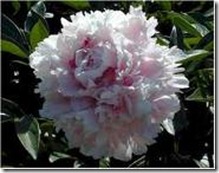Peonies are magnificent plants that may persist in the garden for up to 50 years. They produce huge showy blooms in spring and summer from herbaceous, intersectional and tree-type plants. Intersectional peonies are a cross between tree and herbaceous kinds and die back in fall just like herbaceous peonies. Tree peonies are deciduous, but leave behind a wood skeleton that will bear buds for the following seasons’ bloom. The timing for transplant of any perennial is during fall.
Peony Characteristics
-
Peony don’t bloom for up to three years after they are planted. The plant continues to grow and form larger clusters of foliage over those years to produce more energy for the huge flowers. Peonies bloom in spring and are most suited for cool to temperate climates. There are many types of flowers that get larger than a widespread hand, but all have soft pastel tones and delicate petals. Garden peonies may grow up to 3 feet tall and tree peonies can double that height. Peonies are perennial and continue to bloom for many years.
Pruning Back
-
Herbaceous and Intersectional varieties die back in fall. They can be cut to the crown in fall after they have experienced a few periods of cold temperatures. The foliage is wilted and soft at the time of pruning. Cut them back to within 3 inches of the soil. Tree peonies are different. They do not need to have the woody stems pruned unless you want to diminish the size of the plant or shape it.
Dividing and Moving
-
Peonies can be transplanted or divided in fall, however they should not be removed unless absolutely necessary. Peonies do not respond well to transplanting and may take a season to recover. This means no flowers the year after the plant has been moved. Division is usually not recommended until the plant is 10 to 15 years old. The plant may be cut or pulled apart and needs to have three to four growth nodes in each section. It is not recommended that you plant peonies in the same location again. Plants that are divided regrow and bloom sooner than those that are moved but not divided.
Encouraging Flowers
-
Deadheading as soon as old flowers are spent encourages the plant to produce bigger blooms. Remove them before the plant produces seeds which takes energy that could be used to form larger flowers. Another practice is called de-budding and forces the plant to make larger buds and therefore larger blooms. The buds on the end of the plant remain but the side buds are rubbed off and removed. This seems to put all the energy into the end or terminal buds and cause them to get larger.


Deprecated: strpos(): Passing null to parameter #1 ($haystack) of type string is deprecated in /home/agriviek8Qv/agriviet.net/public_html/wp-includes/comment-template.php on line 2522